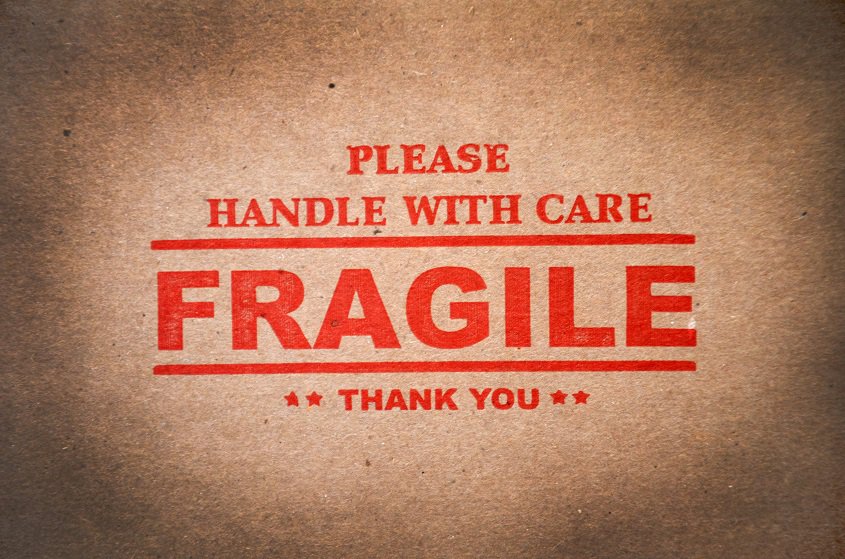Packing for a move is a balancing act. You’re juggling two priorities — getting everything packed fast and compactly, yet at the same time, safeguarding your most precious possessions when working with a moving company.
What’s the best way to prevent the breakage of your valuables? Use the right supplies, take your time, and refer to these 7 pro moving tips to protect from the most often damaged items.
Use New & Certified Moving Supplies
Reusing old cardboard boxes scrounged from friends, or local stores might save you a little cash upfront, but ultimately it’s not worth the risk of damaging your stuff.

Free Ultimate Moving Checklist
Say goodbye to moving stress with our 2023 residential moving checklist for Canada—it’s the ultimate time-saver!
Download NowA better choice would be to get off to a great start with new, high-quality moving supplies. When choosing moving boxes, check the bottom for the manufacturer’s Box Certificate stamp. This is where the manufacturer indicates the box’s sturdiness in terms of:
- maximum weight that the packing box is designed to hold
- stacking strength is determined by the Edge Crush Test, measuring how much pressure it can withstand. The higher this number is, the better your cartons will hold up to the stresses and strains of moving day.
P.S. Once you’ve packed those boxes, be sure to clearly label them as FRAGILE.
Don’t Leave Open Space In Moving Boxes
Avoid leaving open space between items, which can lead to shifting and damage during the moving process.
Instead, plan strategically to fit items close together. Fill empty space and pad your valuables with kitchen towels or crumpled packing paper (which is heavier than newspaper and won’t leave ink stains. Besides, who has newspapers for crumpled paper lying around the house in this century?)
Bubble Wrap Carefully
Along with a trusted moving company, packing with bubble wrap is your best friend when you’re getting ready to move. Besides using it to securely enclose fragile items, cushion their packing boxes top and bottom with a layer or two of bubble wrap as well. You’ll be helping protect them against jolting by the boxes stacked on top or underneath in the moving truck.
Pick The Right Size Box
When you order from the right source, you’ll find moving boxes in a wide variety of sizes and shapes. This makes it simple to pick the proper box (and plastic wrap if required) for special oddly shaped items. Large framed photographs or glass picture frames, for instance, will be much safer in an oversized, flat picture box. Smaller, reinforced china cartons are ideal for delicate kitchenware like wine glasses.
Don’t Cram Moving Boxes
When packed properly your movers will be able to stack your boxes more securely when they are free from lumps, bumps, or bulges (the boxes, not the movers). That means no cramming or overstuffing when you pack those moving cartons.
Are you tempted to wedge in just one more thing? Resist. Future You will be appreciative at unpacking time — when your valuables reemerge, safe and sound from being packed improperly.
Make Use Of Moving Blankets
How do you pack extra-large furnishings like your elegant glass coffee table? Very cautiously with extra cushion. Wrap in moving blankets to protect breakable parts. Bonus: This will also prevent dings to the walls as you move in or out.
Don’t Rush The Process
Allow extra time for any special preparations. Inventory your fragile possessions and decide how best to pack each one. Spend a few minutes measuring doorways to see whether you’ll need to take apart bulky furniture. If possible, make sure when you start packing all breakables go into the truck last and stash them in a designated safe space once they arrive at your new address. That will give you space to unpack slowly and carefully.
6 Common Valuables That Need Proper Packing
Artwork
There’s an art to packing paintings and sculptures — plenty of padding for your delicate items and the right box or wooden crate.
Dishes & Glasses
Packing glasses and dishes properly can be tricky. Plates fare best when packed vertically; drinking glasses and goblets should be protected with dividers.
Mirrors
Choose a purpose-built mirror box to pack a large mirror safely. Add a paper moving pad, and follow up with plenty of packing paper and bubble wrap.
Electronics
Flat-screen televisions and other electronics tend to be as fragile as they are pricey. Repack electronics in their original boxes if you can; otherwise, well-fitting, strong packaging is best. Tip #1: Use antistatic bubble wrap to protect microchips. Tip #2: Always move a flat-screen TV in an upright position. Packing important electronics like your computer, so they’re not damaged during your move is essential. Check out our guide on packing your computer for moving to make this easier.
Gym Equipment
You’ll probably have to disassemble home gym equipment for moving, at least partially—Pack small pieces in clearly labelled plastic bags. Fasten power cords and moving parts to equipment with packing tape, then swaddle the whole bundle in a moving blanket.
Appliances
Here’s where advance planning is essential since so many appliances require special pre-moving prep. To illustrate, you’ll need to leave the dishwasher and washing machine doors open for 48 hours minimum before moving so that any water has time to evaporate. You might also have to book a plumber or technician to disconnect (and reconnect) major appliances. For detailed instructions, consult our Packing Appliances guide.
Cassidy’s Cares
Cassidy’s cares about your valuables. We’ll do our very best to keep them safe throughout your local or long-distance move.

